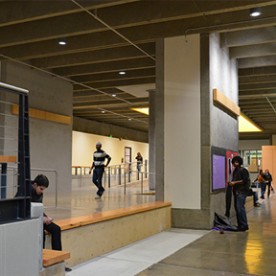This content was published: March 4, 2015. Phone numbers, email addresses, and other information may have changed.
Sylvania’s College Center faces still more phases of improvements
Photos and story by Katherine Miller

The first phase of improvements to Sylvania’s College Center was completed in spring of 2014. It created a more open floor plan with additional seating and improved lighting, acoustics, signage and ADA accessibility.
March 3, 2015
By Katherine Miller
Students, faculty and staff may occasionally consider remodeling work at Sylvania’s Amo DeBernadis College Center (CC) an inconvenience, but to the project manager, GBD Architects’ Keith Skille, the logistics are a “Rubik’s Cube.”
On any given day, hundreds of people work inside CC, while as many as 3,000 or more use its wide range of services, everything from help with financial aid to grabbing a quick meal. And all of the activity must continue while construction work takes place.
Because of the voter-approved bond in 2008, PCC is able to invest $64.6 million in improvements and upgrades at its Sylvania Campus. Overall, crews are renovating about 170,000 square feet of classroom, laboratory and office space, as well as building a 1,500-square-foot storage facility for the automotive building.
The largest project is a modernization of nearly 75 percent of CC, which is happening in multiple phases. Phase I, completed in April 2014, included an overhaul of the lower mall that created a more open floor plan with additional seating and improved lighting, acoustics, signage and ADA accessibility.
Phase I also added a new Answer Center, bringing Enrollment Services, Financial Aid, Student Accounts and the Orientation Center to one central location at the south end of the mall.
In addition, a glass elevator was installed at the north entrance, providing access to all levels of CC and direct access to the Health Technology/CC plaza.
Although not officially designated part of a phase, CC’s new East Entry is currently under construction and when complete will feature a soaring atrium that will house the relocated Welcoming Pole, and also provide flexible, multipurpose space.
Phase II will begin summer of 2015, for occupancy in winter 2016. The work will be done in several stages and includes remodeling offices for several groups, including: Testing Center; Counseling Center; Career Exploration Center; Jobs and internships; International Education; and Student and Graduate Employment Services. Seismic reinforcement work as well as heating, ventilation and cooling (HVAC) upgrades will also be completed during construction of the new offices.
Phase III will begin in winter 2016 and is expected to be completed in summer of 2016. That work includes:
- renovating the Technology Solutions Services’ area;
- performing seismic upgrades and additional structural and ADA accessibility work; completing HVAC work;
- replacing flooring and updating the lighting to a portion of the upper mall.
During construction, the dining and district offices will remain in their original spaces, but other staff will be moved into “swing space” while work is completed. For Skille and college staff, the logistics pose a significant challenge as employees pack up files and desk contents into boxes, then set up in their temporary quarters.
Phase IV will begin summer 2016 and includes:
- completing the finish and lighting updates to the upper mall started in Phase III;
- creating new spaces for various resource centers, including for ROOTS, women, veterans and multicultural groups. Seismic and heating ventilation and cooling upgrades will also be completed.
- developing a new student lounge near the River City Grill, complete with moveable, comfortable seating, dining areas and charging stations.
- restoring Cedar Room;
- creating a staff lounge and staff technology space in the 100 Level.
The architects and designers have been meeting since fall with all the groups who will be moving into the new spaces. “The meetings have gone very well,” said Skille. “The groups have come with great ideas and the plans are coming together nicely.”
But Skille stressed that with all the work still left to be done, plans may evolve. “It’s still very much in flux,” he said. “Depending on how budgets shake out, we may need to reshuffle some things.”
PCC’s 2008 voter-approved $374 million bond program is increasing opportunities for residents to access quality, affordable higher education close to where they live and work. Additional classrooms, updated equipment and technology, and advanced workforce training programs are helping to pave the way for future employment options. For more information, visit the bond website.


Congratulations, Sylvania! This is a significant accomplishment, and the welcoming pole makes an important statement about PCC and our campus’s values and mission. The refurbished pole is beautiful. The restoration work done by Richard Hunt and Gene Flores has brought new vibrancy to it.